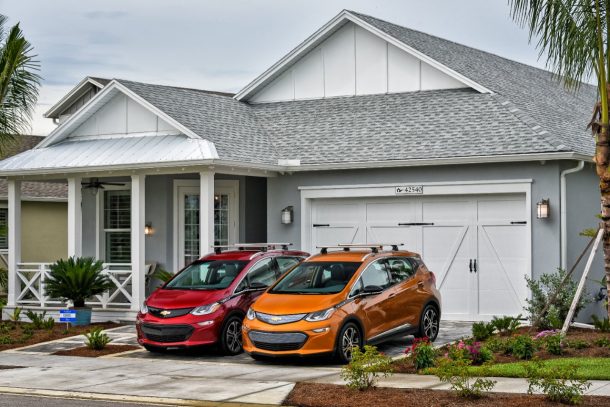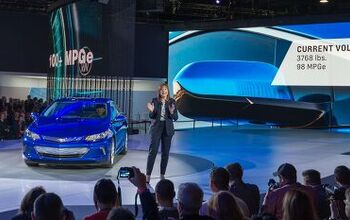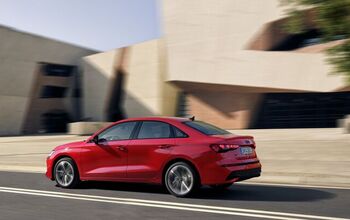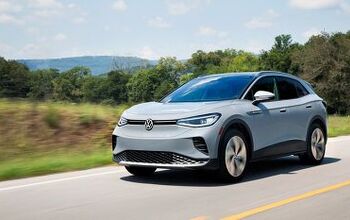General Motors Says Not To Worry, It'll Make Money With Electric Cars

There are a number of things holding up the electric revolution, but one of the biggest obstacles is the high sticker price of battery-powered vehicles compared to internal combustion rivals. General Motors recognizes this wants to reassure potential customers that this won’t be the case forever. On Wednesday, GM President Mark Reuss told the UBS Global Industrials and Transportation Conference that his company will deliver “very average transaction prices” for battery driven vehicles sooner than anticipated.
Many analysts fingered 2025 as the first year we could realistically expect electric cars to fall in line with their ICE counterparts in terms of price. But those earlier predictions are now under fire from world events — notably, uncertainty surrounding the world’s ability to mine the necessary materials at scale, plus a trade war involving one of the world’s largest battery producers.
Helping the prediction are an emerging crop of manufacturing facilities and falling prices that appear at odds with a spike in demand for specific compounds like cobalt.
All the typical consumer knows is that hybrids can be scooped up for a song compared to battery-only vehicles. For example, Chevrolet’s all-electric Bolt slips in just below $37,000 before federal EV tax credits are taken into account. Not terribly far from the average U.S. transaction price for a new car, but far more expensive than a typical compact, even with the incentives.
That’s not just true for General Motors; most manufacturers selling BEVs do so at demonstrably higher prices because they have to. Battery-driven vehicles are not yet the great money makers their creators envision; automakers ultimately have to court the buyers with more to spend.
From Bloomberg:
GM announced in October 2017 that it plans to sell 20 electric-vehicle models globally by 2023. At the time, Reuss said the company’s EV technology is engineered to be low cost and make money. He went a step further today, saying GM’s program will make money without luxury-vehicle prices.
GM and most carmakers currently lose money selling electric cars. Tesla has put up a few profitable quarters, but even with its Model 3 selling for about $45,000 or more and the Models S and X often going out the door at more than $100,000, it struggles to make money. To boost revenue, it sells clean-air regulatory credits to companies that market far more gas guzzlers than EVs.
Part of that is due to EVs being lower-volume vehicles, the high price of materials, lofty development costs related to new technologies, and more. But it’s all being dealt with, according to Reuss. “We’ll reach parity a lot sooner than people think,” he said. “We’re driving down the cost of batteries and the whole EV in general.”
As Wards Auto reports, one thing working in GM’s favor is an upcoming electric platform capable of handling 10 bodystyles and appearing under a wide variety of vehicles, maximizing economies of scale.
While it would have been nice to get an official date for GM’s electric break-even point, we may be able to cobble together a loose timeline of our own. Bloomberg noted that battery packs for electric cars currently cost about $150 per kilowatt hour, according to consulting agency McKinsey & Co., adding that Reuss said GM required less than $100 per kilowatt hour to see any profit.
The more ambitious estimations, frequently promoted by energy consortiums and battery firms, suggest $100 per kWh is feasible by 2025. Lei Zhang, founder and CEO of China’s Envision Energy, has previously said prices could sink as low as $50 per kWh by 2025 and the $100 mark could be reached by 2020 under idyllic circumstances. He was not alone. Numerous “EV experts” and manufacturers claim lithium-ion batteries are on the verge of achieving a crucial milestone in terms of price and technology. As that’s been the narrative for years now, we’re inclined to take a more conservative view. While 2025 looks like the first year EVs could reach price parity, that’s not the same as saying it will be.
[Image: General Motors]

A staunch consumer advocate tracking industry trends and regulation. Before joining TTAC, Matt spent a decade working for marketing and research firms based in NYC. Clients included several of the world’s largest automakers, global tire brands, and aftermarket part suppliers. Dissatisfied with the corporate world and resentful of having to wear suits everyday, he pivoted to writing about cars. Since then, that man has become an ardent supporter of the right-to-repair movement, been interviewed on the auto industry by national radio broadcasts, driven more rental cars than anyone ever should, participated in amateur rallying events, and received the requisite minimum training as sanctioned by the SCCA. Handy with a wrench, Matt grew up surrounded by Detroit auto workers and managed to get a pizza delivery job before he was legally eligible. He later found himself driving box trucks through Manhattan, guaranteeing future sympathy for actual truckers. He continues to conduct research pertaining to the automotive sector as an independent contractor and has since moved back to his native Michigan, closer to where the cars are born. A contrarian, Matt claims to prefer understeer — stating that front and all-wheel drive vehicles cater best to his driving style.
More by Matt Posky
Latest Car Reviews
Read moreLatest Product Reviews
Read moreRecent Comments
- MaintenanceCosts Can I have the hybrid powertrains and packaging of the RAV4 Hybrid or Prime with the interior materials, design, and build quality of the Mazda?
- ToolGuy I have 2 podcasts to listen to before commenting, stop rushing my homework.
- ToolGuy Please allow me to listen to the podcast before commenting. (This is the way my mind works, please forgive me.)
- ToolGuy My ancient sedan (19 years lol) matches the turbo Mazda 0-60 (on paper) while delivering better highway fuel economy, so let's just say I don't see a compelling reason to 'upgrade' and by the way HOW HAVE ICE POWERTRAIN ENGINEERS BEEN SPENDING THEIR TIME never mind I think I know. 😉
- FreedMike This was the Official Affluent-Mom Character Mobile in just about every TV show and movie in the Aughts.


































Comments
Join the conversation
US? probably not for a while. China or Europe? Somewhat likely. There're lots of room to cut taxes on cars to make EV competitive. Why cut taxes on cars? They probably don't get the cheap oil we get and they don't want to constantly deal with the chaos in the oil businesses (middle east, africa, latin america, russia, etc). They probably factor those into the cost of oil.
GM has never been able to sell more than 20,000 electric vehicles a year. Tesla produces ten times as many electric vehicle than GM does annually. Why does GM even bother. I have heard stories of Bolts being on dealers lots for more than six months.